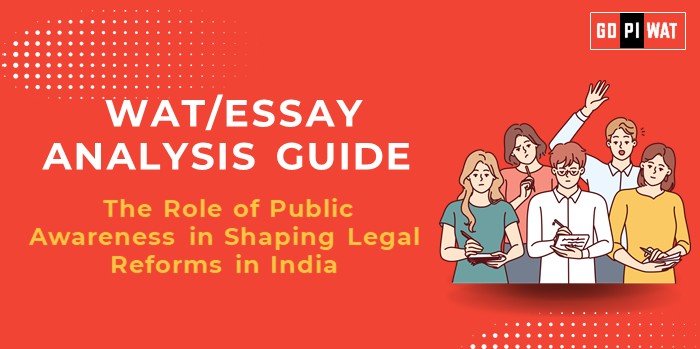📋 Written Ability Test (WAT)/Essay Analysis Guide: Public Awareness as a Catalyst for Legal Reforms
🌐 Understanding the Topic’s Importance
Public awareness serves as the catalyst for legal reforms, influencing legislative agendas and ensuring democratic accountability. For B-schools, the topic underscores the importance of social responsibility in leadership.
⏱️ Effective Planning and Writing
- Time Allocation: 5 minutes for planning, 20 minutes for writing, 5 minutes for review.
- Preparation Tips: Compile examples like RTI, Nirbhaya movement, and Vishaka Guidelines.
💡 Introduction Techniques for Essays
- Contrast Approach: “India is a land of paradoxes – while RTI applications have empowered millions, legal illiteracy still prevails in rural areas.”
- Solution-Based: “Public awareness has proven instrumental in reforming outdated laws, such as the abolition of triple talaq.”
📖 Structuring the Essay Body
- Achievements: PILs democratizing justice, digital campaigns increasing awareness.
- Challenges with Comparative Analysis: India’s slow judicial processes vs. Scandinavian legal education models.
- Future Outlook: Digital legal literacy and grassroots advocacy shaping India’s legal reforms.
📄 Concluding Effectively
- Balanced Perspective: “The interplay of public awareness and legal reforms reflects a participatory democracy in action, though challenges remain in accessibility and literacy.”
- Global Comparison: “India can adopt best practices from nations with established community legal services.”
📊 Analyzing Successes and Shortcomings
- Achievements: Increased transparency, progressive legal judgments.
- Challenges: Legal jargon, rural exclusion.
- Global Context: Community-driven legal aid in Nordic countries.
✨ Recommendations for Sustainable Progress
- Introduce legal literacy programs in schools.
- Leverage social media for digital legal awareness.
- Foster public-private partnerships for legal aid services.
📑 Sample Short Essays on the Topic
Balanced Perspective:
“Public awareness drives legal reforms by bridging the gap between the people and policymakers, as seen in RTI’s success. However, deeper literacy efforts are essential for equitable justice.”
Solution-Oriented:
“Empowering citizens with legal knowledge through technology and education can catalyze inclusive legal reforms in India.”
Global Comparison:
“India’s public-driven legal reforms, such as the PIL mechanism, align with Nordic countries’ community legal service models, but greater emphasis on rural inclusion is needed.”


